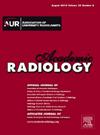Contrast Enhancement of Cochlea after Direct Microneedle Intracochlear Injection of Gadodiamide through the Round Window Membrane with Minimal Dosage
IF 3.8
2区 医学
Q1 RADIOLOGY, NUCLEAR MEDICINE & MEDICAL IMAGING
引用次数: 0
Abstract
Rationale and Objectives
The potential of contrast-enhanced MRI for diagnosing endolymphatic hydrops is limited by long wait times following intravenous (IV) or intratympanic (IT) delivery, high contrast dosages, and inconsistent signal intensity enhancements. This study investigates microneedle-mediated intracochlear (IC) gadodiamide injection for consistent and efficient contrast delivery with minimal contrast dosage.
Materials and Methods
A 100 µm diameter microneedle with 35 µm lumen was used to inject 1 µL of diluted gadodiamide (17.4 mM) into a guinea pig cochlea via the round window membrane. Serial MRI imaging was performed in a post-mortem animal using a 9.4 T small-animal MRI. Maximum intensity projections of MRI scans were generated to visualize diffusion of contrast within cochlea over time; mean intensities in defined regions of interest (ROIs) were calculated. Contrast diffusion time and intensity enhancements were determined.
Results
Contrast was observed in the basal turn of scala tympani (ST) and scala vestibuli (SV) in the first MRI scan for all subjects which was acquired as early as 35 min after injection. Two-tailed paired t-tests confirmed that contrast reached the first two turns of ST and SV within 60 min, and the second half of third turns and apical turns of ST and SV within 90 min (p < 0.05). Intensity enhancements, defined as the percentage increase of the ROI mean intensity in the injection side compared to the contralateral side, exceeded 100% in the first turn and ranged from 12% to 32% in the third and apical turns of ST and SV at 90 min after injection.
Conclusions
IC gadodiamide enables controllable and efficient contrast delivery with significantly lower contrast dosage, making it a viable alternative for contrast-enhanced cochlear MRI.
通过圆窗膜直接微针蜗管内注射钆双胺,以最小剂量增强耳蜗对比度
理由和目标:造影剂增强 MRI 诊断内淋巴水肿的潜力受限于静脉注射(IV)或耳内注射(IT)后等待时间长、造影剂剂量高以及信号强度增强不一致。本研究调查了微针介导的耳蜗内(IC)钆二胺注射,以最小的造影剂剂量实现一致、高效的造影剂输送:使用直径 100 微米、内腔 35 微米的微针,将 1 微升稀释的钆双胺(17.4 毫摩尔)通过圆窗膜注入豚鼠耳蜗。使用 9.4 T 小动物核磁共振成像仪对死后动物进行连续核磁共振成像。生成核磁共振成像扫描的最大强度投影,以观察对比剂在耳蜗内随时间推移的扩散情况;计算确定的感兴趣区(ROI)的平均强度。结果:结果:所有受试者在注射后 35 分钟获得的第一次 MRI 扫描中,均在鼓室(ST)和前庭(SV)的基底转折处观察到对比度。双尾配对 t 检验证实,造影剂在 60 分钟内到达 ST 和 SV 的前两圈,在 90 分钟内到达 ST 和 SV 的第三圈的后半部和顶圈(p 结论):IC 钆可实现可控、高效的造影剂输送,且造影剂用量大大降低,是造影剂增强耳蜗磁共振成像的可行替代方法。
本文章由计算机程序翻译,如有差异,请以英文原文为准。
求助全文
约1分钟内获得全文
求助全文
来源期刊

Academic Radiology
医学-核医学
CiteScore
7.60
自引率
10.40%
发文量
432
审稿时长
18 days
期刊介绍:
Academic Radiology publishes original reports of clinical and laboratory investigations in diagnostic imaging, the diagnostic use of radioactive isotopes, computed tomography, positron emission tomography, magnetic resonance imaging, ultrasound, digital subtraction angiography, image-guided interventions and related techniques. It also includes brief technical reports describing original observations, techniques, and instrumental developments; state-of-the-art reports on clinical issues, new technology and other topics of current medical importance; meta-analyses; scientific studies and opinions on radiologic education; and letters to the Editor.
 求助内容:
求助内容: 应助结果提醒方式:
应助结果提醒方式:


